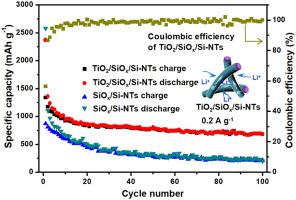Colloids and Surfaces A: Physicochemical and Engineering Aspects ( IF 4.9 ) Pub Date : 2021-05-23 , DOI: 10.1016/j.colsurfa.2021.126870 Jiao Li , Yuanbiao Li , Jiao Shi , Haibin Liu , Dewen Wang , Wenlu Zhai , Zhaoxu Meng

|
A TiO2/SiOx/Si composite derived from cellulosic cotton as the structural template was biomimetically synthesized. Modified sol–gel deposition processes were performed to coat each cellulose nanofiber with a SiO2 thin gel layer, followed by layer-by-layer self-assembly processes to form an external TiO2 coating with controllable thickness. The resulted matter was calcined in air to obtain the TiO2/SiO2 composite, which was successively put in N2 atmosphere and treated with magnesiothermic reduction reaction, resulting in the final TiO2/SiOx/Si composite. The composite possessed a typical hierarchical three-dimensional (3D) nanotubular network microstructure precisely inherited from the cellulosic cotton template, and each nanotube had a core-shell nanostructure with Si-based matters as the core and TiO2 coating as the shell. Compared with the bare nanotubular SiOx/Si material, the TiO2/SiOx/Si composite showed a highly enhanced electrochemical performance as an anode material for lithium-ion batteries (LIBs), delivering an initial discharge capacity of 2370 mAh g−1 at a current density of 0.2 A g−1 (an initial Coulombic efficiency of 56.4%), a reversible capacity of 682 mAh g−1 after 100 discharge/charge cycles, and a discharge capacity of 241 mAh g−1 at a high current density of 2.0 A g−1. The excellent specific capacity, cycling stability and rate capability are ascribed to the synergistic effect of the unique 3D porous nanotubular network structure and the uniform TiO2 coating layer, which accommodates the volume variation of Si-based components during cycling, offers sufficient ion transport pathways and improves the electron transfer efficiency. This work provides a facile biomass-based strategy for fabrication of metal oxide/Si composites with well-defined microstructures that exhibit significant potential as anode materials for LIBs.
中文翻译:

纤维素棉衍生的纳米管TiO 2 / SiO x / Si复合材料作为锂离子电池的负极材料,具有增强的电化学性能
仿生合成了以纤维素棉为结构模板的TiO 2 / SiO x / Si复合材料。进行了改良的溶胶-凝胶沉积工艺,在每根纤维素纳米纤维上涂覆了SiO 2薄凝胶层,然后进行逐层自组装工艺,以形成厚度可控的外部TiO 2涂层。将所得物质在空气中煅烧以获得TiO 2 / SiO 2复合材料,将其依次置于N 2气氛中并用镁热还原反应处理,得到最终的TiO 2 / SiO x/ Si复合材料。该复合材料具有典型地从纤维素棉模板继承而来的三维三维(3D)纳米管网络微观结构,并且每个纳米管均具有核-壳纳米结构,其中硅基物质为核,TiO 2涂层为壳。与裸露的纳米管SiO x / Si材料相比,TiO 2 / SiO x / Si复合材料作为锂离子电池(LIBs)的负极材料具有更高的电化学性能,初始放电容量为2370 mAh g -1在0.2 A g -1的电流密度(初始库仑效率为56.4%)下,可逆容量为682 mAh g -1在100次放电/充电循环之后,在2.0A g -1的高电流密度下的放电容量为241mAh g -1。优异的比容量,循环稳定性和速率能力归因于独特的3D多孔纳米管网络结构和均匀的TiO 2涂层的协同效应,该涂层可适应循环过程中基于Si的组分的体积变化,并提供足够的离子传输路径并提高了电子转移效率。这项工作为制造具有明确定义的微结构的金属氧化物/硅复合材料提供了一种基于生物质的简便策略,该复合材料具有显着的潜力,可作为LIB的阳极材料。


















































 京公网安备 11010802027423号
京公网安备 11010802027423号